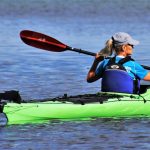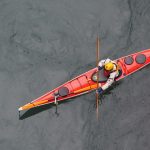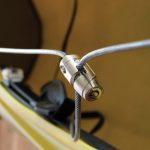Keeping your kayak on track in heavy winds and choppy water is not easy. That is where kayak skegs and rudders come in handy.
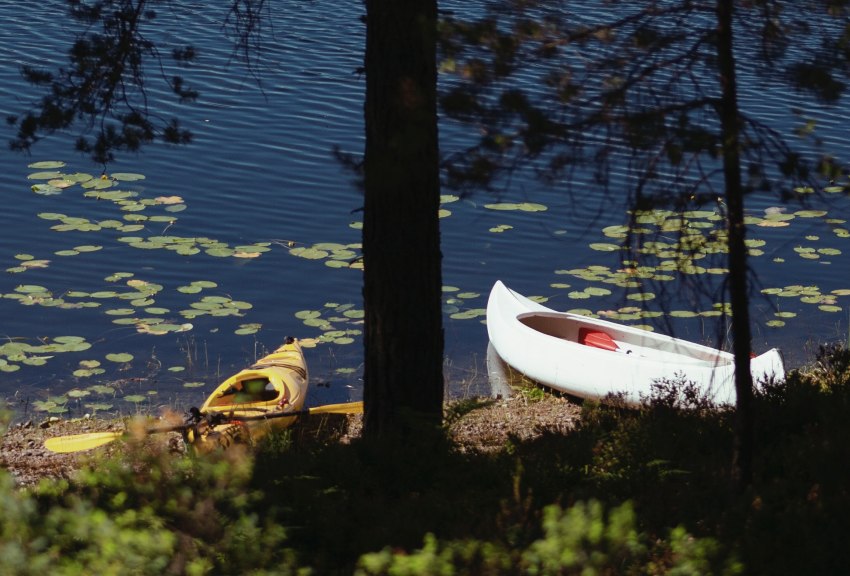
Ahh, the age-old debate of kayak vs. canoe!
It’s been an argument since the earliest water sports existed—heck, long before that, since the first European colonists of the New World first compared their small water craft to those of the Aleut and Inuit and (probably) immediately wanted to establish which was better.
Both kayaks and canoes have been used in water travel and hunting for literally thousands of years, and they’re still widely in use today by hobbyists and athletes alike.
You’ll find few lakes in the U.S. or Canada that haven’t been paddled by someone in either a kayak or a canoe.
But which is better? That’s the big question, isn’t it?
If you’re looking to buy your first small water craft and aren’t sure which is the better choice for you, you’ve come to the right place!
Below, we’re going to take a deep dive into the kayak vs. canoe debate, examine each very carefully, and help you understand which will suit your specific needs, experience level, destination, and use best.
Get ready for some fun, and let the debate begin!
Don’t Have Time for A Full Read? Here’s What You Need to know!
Kayaks:
- Are better-suited to beginners
- Are easier to paddle
- Track better in the water thanks to the two-headed paddle
- Are highly versatile and can handle both calm and open/rough water with ease
- Are typically lighter and easier to solo-transport
- Are more maneuverable due to their shorter length and lower weight
- Protect you from the elements (water and wind) and keep you dry
- Include some storage
Canoes:
- Are more stable and less likely to tip over
- Are easier to enter and exit
- Can carry A LOT of gear
- Give you a better view of your surroundings
- Are easier to portage, especially when traveling with gear
- Are more comfortable and provide more legroom
- Can fit multiple paddlers
- Allow you to stand up (carefully!)
- Are great for traveling with kids and pets that want to get in and out of the water
Kayak vs. Canoe: The Main Differences Start With Design
Let’s dive into the kayak vs. canoe debate and start out by looking at the major design differences between both watercraft.
Kayak Shape and Size
We explained kayak anatomy in this post, so I recommend you head over and check it out for a full breakdown of kayak components and features.
For the sake of this post, however, I’ll give you the short version…
Kayaks are typically designed to be narrow, sleek, and built for speed.
There are two basic types of kayak designs:
1) Sit-in – This is a closed cockpit design that rides lower in the water, but the walls of the kayak keep out water. It can be paired with a spray skirt to keep you fully dry even after an hours-long paddle.

2) Sit-on-top – With this design, there is no cockpit, but you’re sitting on a seat built on top of the kayak. These tend to be wider and more stable, but they offer no protection from the elements.
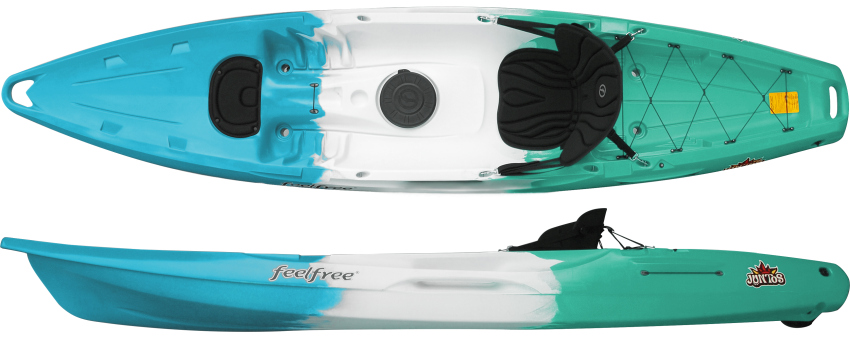
Kayaks come in all styles depending on their intended use:
- Recreational kayaks are typically lightweight, intended to be used on calm, flat water (like a lake or peaceful ocean), and are usually 9-12 feet long (though you can find some as short as 6’ and as long as 17’).
- Touring kayaks—also known as sea kayaks or expedition kayaks—are designed for long-distance ocean use, built with a narrow, sleek design capable of greater speeds for long-haul travel. They offer more storage space and may include a skeg, rudder, and even the ability to add a sail. They’re usually in the 12-18’ range.
- Fishing kayaks are wider and very stable, typically of the sit-on-top variety. They include wells for your tackle box, drink holders (a beautiful addition!), and even fishing rod holders. They’re not ideal for speed, but they are great for sitting all day long and standing up to cast.
- Racing kayaks are built entirely for speed, meaning they are very long (17-36’) and very slender. They’re built to accommodate multiple racers, include a rudder to improve tracking, and are typically paddled (in a marathon or sprint race) on flat water.
Canoe Shape and Size
Canoes are all designed with an open cockpit and high gunwales (the “walls” of the boat) that elevate the paddler far above the water level. They look like a classic rowboat, but sleeker and narrow enough that one person can paddle alone.
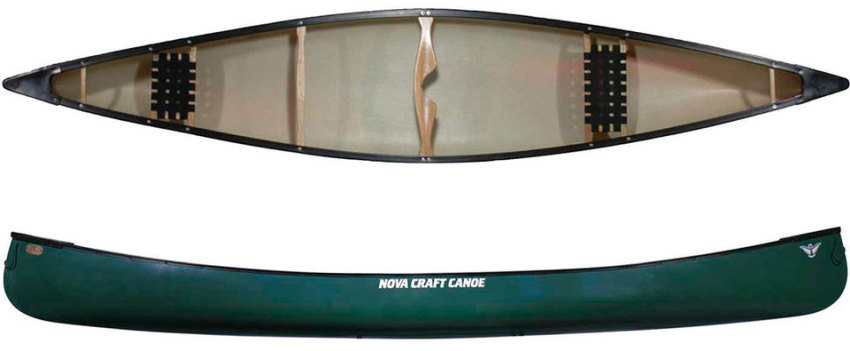
They’re typically built for stability, easier navigation, and transporting cargo over long distances.
Canoes come in a few different styles:
- Recreational canoes usually range between 13 and 17 feet long, and sized for 1-3 rowers to maneuver with ease. They have excellent primary stability and are ideal for lakes, slow-moving rivers, and calm coastal waters.
- Racing canoes are narrower and ride a bit lower in the water, which helps them achieve better speeds and makes them more maneuverable for solo/duo racing.
- Whitewater canoes are much shorter than regular canoes (9-12’) but have a much higher rocker (upward curvature of the kayak hull) for greater mobility. They’re typically less stable but allow for easier balance on turbulent rivers and whitewater rapids.
You can see that kayaks offer more options, which makes them the more versatile boat with a wider range of uses.
Kayak vs. Canoe Seats
Another major design difference between kayaks and canoes is the seat. And trust me, after a long day of paddling, a good seat is worth everything!
Kayak seats are set close to the bottom of the hull, often at or beneath water level. Paddlers sit with their legs extended out directly in front of them (feet pressed against pedals or footrests), and with their back supported by the seat’s accompanying backrest. The seats also tend to have more padding and a contoured, ergonomic design.
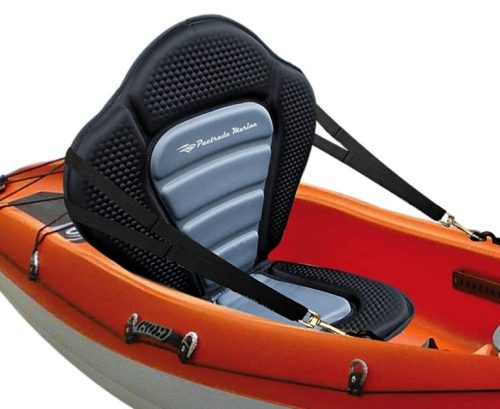
For those with lower back problems (like me), a good kayak seat can offer excellent lumbar support and keep you from feeling a strain while paddling. On the other hand, the leg-extended position can cause numbness and discomfort due to pressure on your buttocks/hamstrings reducing blood flow to your lower limbs (a problem I’ve tried a lot of solutions but still can’t fully deal with!).
Canoe seats tend to be simpler—typically some sort of padding mounted atop the crossbars (at the front and rear) to provide a bit of cushioning. Some recreational canoes will come with a bench-style seat, or you can just find and mount your own (I’ve been using the GCI Outdoor SitBacker for a year now, mainly for its lumbar support).
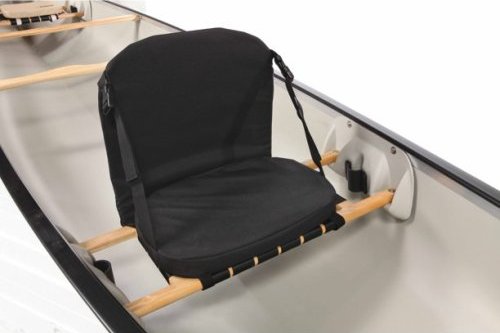
The seat is elevated (at the highest point on the canoe’s body) so you’re actually high above the water’s surface. This makes for easier navigation, better views, and more power for rowing.
For more intense rowing (like racing), you can actually adopt a half-seated, half-kneeling position to really put some oomph behind your strokes.
Kayak vs. Canoe Paddles
One more major difference we need to talk about: the paddles.
Kayak paddles are two-headed, meaning they have a head at each end of the paddle. This makes it easy to alternate strokes in a smooth, circular motion that feels very natural on your arms, shoulders, and core muscles.

Canoe paddles are one-headed, meaning they just have a paddle at one end (and a handle-style knob at the other). To paddle, you have to switch hands constantly to alternate the strokes on either side of the boat.

As you can imagine, paddling a kayak is much easier—both in terms of efficiency of motion and conservation of energy. There is no wasted movement or energy changing hands, making maneuvering the kayak a much easier prospect than the canoe.
Note: There is a cool technique called the “J-Stroke” that will allow you to paddle more efficiently without having to change sides/switch hands all the time. Our friends at Canoeing TV have an excellent instructional video to show you how it’s done.
Choosing a Kayak vs. Canoe: Factors to Consider
Now that we’ve talked about the design differences between kayaks and canoes, it’s time to see how those differences actually affect the use of these two watercraft.
Kayak vs. Canoe: Learning Curve
If you’re a total beginner looking to buy your first small watercraft, this is an important factor to consider. After all, you want to hit the water and enjoy yourself now!
For beginners, kayaks are the clear winner. Literally, all you have to do is climb in (without tipping over like I did my first time!), sit down, and get paddling.
Yes, you’ll have to learn that digging your paddle on the boat’s left side will push you right, and digging in on the right will push you left. It’s a tad tricky until you make sense of that.
But once you do, can pick up the strokes within a matter of minutes. You’ll be zipping around the lake and loving it right away because of how easy it is to master the kayak paddling stroke.
Canoes, on the other hand, are a bit trickier to master. There are a number of strokes you’ll need to learn in order to canoe well (check out this post by the Appalachian Mountain Club about the five most important canoe strokes).
But, once you master the strokes, you’ll find that you’re pretty much set. You can handle more advanced water (coastal and river) with the strokes you’ve learned. It’s not too difficult to go from intermediate to expert-level paddling once you’ve got the basics of canoe paddling down.
Kayak paddling, on the other hand, gets a bit more complex when you get to more turbulent or tricky waters. More advanced paddling can be harder to learn, so there is a longer learning curve if you want to transition from recreational to whitewater or expedition kayaking.
To Sum Up: Kayaks are easier on beginners, but harder to master. Canoes take some practice to get the hang of, but once you know, you’re good to go!
Speed: Is A Kayak Faster Than a Canoe?

Let’s be honest: there’s a little bit of a speed demon in all of us.
You may be the most mild-mannered person around, but when you get out on that water with the sun shining bright and the wind flying in your face, nothing feels quite as spectacular as zipping across a lake at top speed.
Kayaks win the battle for speed every time due to their design.
1) They’re lower in the water, so you encounter less wind resistance.
2) The double-bladed paddle can row more efficiently than the canoe’s single-bladed paddle.
3) They are narrower than canoes, and there is less of the kayak in contact with the water—which translates into less water resistance and drag.
4) They are typically lighter than canoes (on their own, and with gear), which takes less effort to paddle.
Looking at the world records for kayak vs. canoe speeds, you can see this playing out very clearly.
- The 200m sprint time is 33.38 seconds in a kayak vs. 37.44 seconds in a canoe
- The 1000m (K4) record is 2 minutes, 46.72 seconds in a kayak vs. 3 minutes 10.7 seconds in a canoe
- The 5000m record is 18 minutes in a kayak vs. 20 minutes, 27.35 seconds in a canoe.
However, there is an important caveat to this: your paddling stroke will play a huge factor in speed.
As I mentioned above, kayaks are a bit more finicky with the paddling. Experienced paddlers will know how to keep the boat tracking straight, but beginners will find it’s harder to keep the kayak on track.
Why does this matter? Well, let’s put it this way: because kayaks will zigzag a lot more than canoes, you might find that even with greater speed capacity, a novice kayaker might lose a straight Point-A-to-Point-B race to a canoe that tracks straight.
Only once you master the more advanced kayak paddling tricks will you really be able to really get zooming.
To Sum Up: Kayaks can reach top speeds much higher than canoes (and typically at a faster pace). However, canoes track straighter in the water, making for a more direct line of travel than zigzagging kayaks.
Kayak vs. Canoe: Stability

Stability is absolutely critical when out on the water, which is, by its very nature, entirely unstable.
Both boats are designed to float on the water, providing a solid and stable surface to bear your weight (and that of your gear).
As we explained above:
- Canoes ride higher in the water, but have a wider beam.
- Kayaks ride lower in the water, and are often narrower.
How does this translate into stability/instability?
Simple: the wider the beam, the more primary stability it has, but the lower its secondary stability.
Let’s get technical: Primary stability refers to how stable it is when at rest on flat, calm water. Secondary stability refers to its stability when leaned or tipped onto its side/edge in rougher water—or, put another way, how likely it is to capsize when tipping over.
Canoes have much higher primary stability than kayaks, thanks to their wider beam. This makes it significantly easier to climb in and out of the canoe without rocking or tipping over. You can also stand up in the canoe , move around, play with your kids or pet, reorganize your gear, shift seats, and more. As long as the water is flat and calm, canoes will always be more stable than kayaks.
But, and this is a big but, if you’re going on water that is even a little bit rough or choppy, you’ll find canoes tend to rock a lot, and are more prone to tipping over. This is because their wide beams decrease their secondary stability. Once the canoe starts leaning onto its edge, it’s far more likely to tip over than a kayak.
Kayaks ride lower in the water and tend to have a narrower beam. This means they don’t have great primary stability—which can make them a bit hard to get into at first, and not very stable if you’re moving around inside—but they can handle rough water like a boss. That’s why they’re more commonly used for whitewater paddling and long-haul voyages across the open ocean.
To Sum Up: Canoes have significantly better primary stability, but a kayak’s superior secondary stability makes it far better to handle on rough and choppy water.
Safety: Are Kayaks or Canoes Safer?
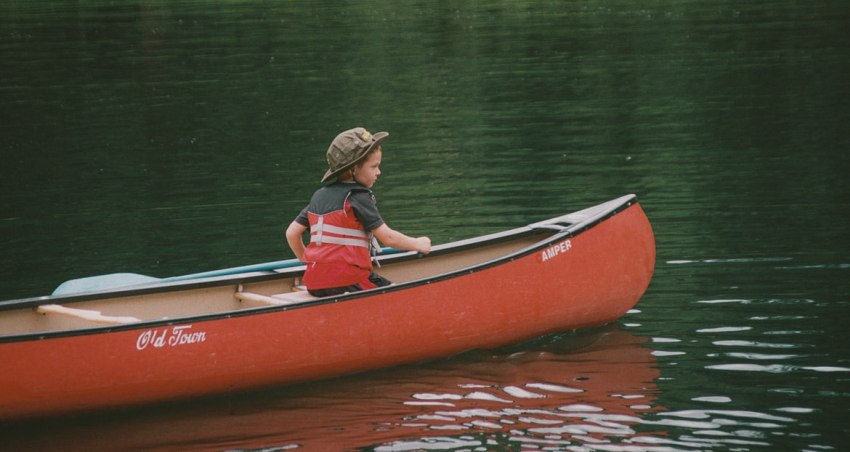
Safety out on the water is closely linked to the kayak or canoe’s stability.
Simply put: the more stable the craft, the less likely you’ll be to tip over and fall into the water, so the safer you are.
You already know that canoes are more stable on calmer water, and kayaks are more stable when the water gets choppy. So if you’re going to be hitting up a tranquil lake or slow-moving river, a canoe may be the safer choice. On the other hand, if the wind picks up and the water gets rough, the kayak may ultimately prove safer.
But that’s not all. You’ve also got to consider what to do in case the kayak or canoe ultimately does tip over. It’s going to happen at some point in your many years of kayaking!
In order to self-rescue, you’ve got to be able to:
A) Swim back to dry land, pulling or pushing the kayak/canoe with you (easy if you’re paddling close to shore), so you can right it and empty out the water.
B) Flip the kayak/canoe back over while in the water (what will happen if you’re paddling out in the middle of the river or lake) and bail out the water so you can paddle back to shore.
This is where the design once again comes into place.
Canoes are very stable and unlikely to tip over. Of course, this means they’re also much harder to right if they do capsize.
Kayaks, on the other hand, tip over more easily but are also far easier to right. Many are actually designed with handles you can use to roll the kayak back upright with surprisingly little effort.
To Sum Up: Canoes are safer on calm waters, kayaks on rougher, choppier waters. Canoes are less prone to tipping but also more difficult to right. Kayaks may be more likely to tip, but they’re easier for self-rescue.
Comfort

Comfort is absolutely a factor to consider when canoe or kayak-shopping. After all, if you’re planning a multi-hour (or multi-day) paddling trip, you’ve got to make sure the craft is comfortable enough to row all day long.
Canoes are more spacious, with a lot more legroom (a big deal for a 6’6” guy like me!). You can move around more and even stand up to stretch your legs whenever you want.
Kayaks have smaller cockpits, with only enough leg room to shift positions slightly, but never stand or stretch your legs fully. You’ll also stay in the seated position all day long, which can be uncomfortable.
Kayak seats are designed with this in mind, so they typically feature more padding and better lumbar support than canoe seats.
One very cool thing about canoes, though: you can actually sleep in them, when you go canoe camping. All you have to do is remove the central crossbars, and you’ve got enough space to stretch out—even if you’re carrying a lot of gear.
Our friends over at Adventures in Reach have a nifty video on how to sleep in your canoe.
To Sum Up: Kayak seats tend to be more comfortable than canoe seats, but overall, canoes are more comfortable—even spacious enough to sleep in, perfect for a multi-day trip.
Maneuverability
If you’re paddling on a calm lake or river, you might not think maneuverability is so important. After all, you’re just kind of going “there and back again”, or circling the lake.
But take the kayak or canoe too close to the shore, through rocks, or along the coastline, and maneuverability becomes a critical factor. Even on rivers and lakes, you’ve got plenty of dangers of kayaking—sweepers, strainers, overhangs, and underwater obstacles—to navigate around.
Just looking at the kayak vs. canoe design, and it’s pretty clear to see that the sleeker, lighter kayaks are more maneuverable than heavier, wider canoes. Kayaks were originally designed by the Inuit and Aleut to navigate ice floes and treacherous water.
The average recreational kayak also tends to be shorter than a canoe—9-12 feet vs. 13-17 feet. Shorter means greater maneuverability and faster response to your paddling strokes. Some kayaks even come with a rudder or skeg to improve tracking and steering, making handling the craft even easier.
To Sum Up: What canoes gain in stability and length, they sacrifice in maneuverability. Kayaks are typically easier to steer and handle than canoes.
Transporting a Kayak vs. Transporting a Canoe
When I talk about transporting your canoe or kayak, I’m referring to two different types of transportation:
1) Transporting the vessel on your vehicle – You’ve got to get the kayak or canoe from your home to the water, which typically means loading it up on your vehicle (on a roof rack or trailer) and driving it to the lake, river, or seaside.
2) Transporting the vessel between lakes and rivers – This is called “portage”. Essentially, you’re hauling the kayak across dry land—a forest trail, up a mountain, along a riverbank, etc.—to get it from one body of water to another.
Let’s start with transporting the kayak or canoe on your vehicle.
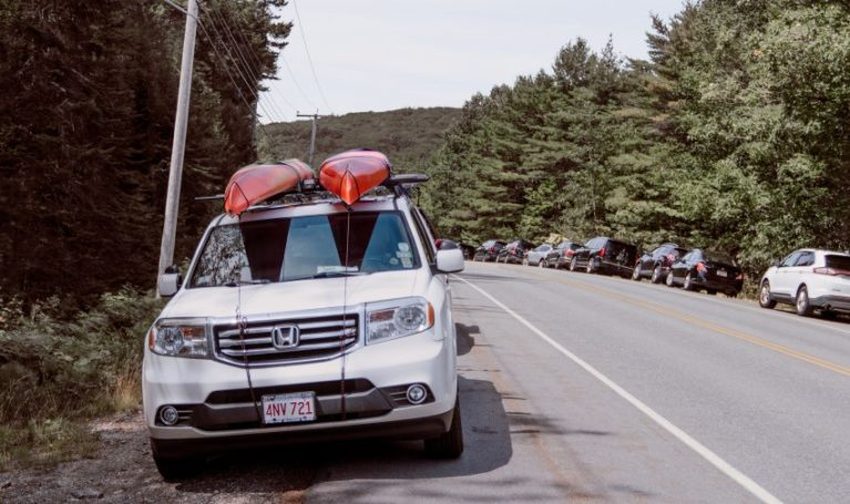
Obviously, there are a lot of solutions for transporting both. Most of them are either racks mounted to your roof, trailers hitched to the back of your vehicle, or an actual carrying frame mounted on a truck bed.
We’ve got a comprehensive guide to the best kayak roof racks.
Or, if your vehicle doesn’t have built-in rails for a crossbar, we’ve got some interesting ways you can transport your kayak or canoe without a roof rack.
And, of course, I’ve done a complete breakdown of the best kayak trailers to pull your kayak or canoe behind your car.
As you can imagine, transporting the shorter, lighter vessel (a kayak) is definitely easier, and there are far more racks and trailers compatible with kayaks. This makes hauling it on your vehicle easy and inexpensive.
There are racks and trailers capable of carrying your canoe, but there are fewer options to choose from. Because the canoe is longer and heavier, you’ll only be able to carry one—versus 2-4 on a kayak rack.
When talking about portaging, or transporting your kayak or canoe between two bodies of water by hand, that’s when things get flipped on their head.
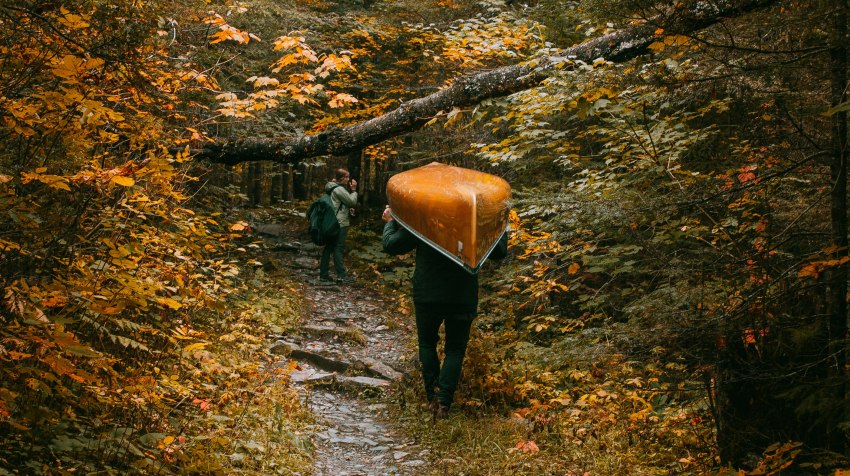
Canoes are typically easier to portage (either solo or with a partner) because they’re easier to load/unload, and sit more comfortably on your shoulders/back than a kayak. Their weight is also easier to distribute as you’re carrying them.
RELATED: Best Lightweight Canoes: Ultimate Guide and Reviews
That being said, kayaks do offer a few options that make for easier portaging:
- Kayak straps or yokes that help you to bear the weight of the kayak on your back/shoulders
- Kayak carts, trolleys, and wheels that will do most of the heavy lifting for you
To Sum Up: Kayaks are easier to transport on your vehicle, but canoes make for easier portaging.
Gear Storage
If you’re planning an all-day or multi-day trip, you’re going to need to haul gear with you.
Sleeping bags, food, water, dry clothing, cooking supplies, tools, and the list goes on…
Kayaks typically come with one or two dry storage compartments that can hold a moderate amount of gear, usually enough for a day or so.
Canoes, on the other hand, have enough space for a lot of gear. And I mean a lot! The average-sized canoe can hold enough supplies for a multi-day trip. See our review of the best canoes on the market to see how spacious different models can be.
I like to say that kayaks are better for solo boating trips, where you just bring everything you need for yourself and nothing extra.
Canoes are the better option if you’re camping or traveling with buddies, and you want to haul more gear and don’t mind the extra weight.
To Sum Up: Canoes have significantly more storage space than kayaks.
Water and Weather Conditions
We’ve talked a bit about which vessel is better suited to which water and weather conditions, but I want to highlight this topic one more time just to make sure it’s clear:
Kayaks:
- Perform better on the open sea, choppy lakes, fast-flowing rivers, and white water. Their better secondary stability keeps them from tipping over even in high surf or rough waters.
- Are better if the weather is cold or windy, because the spray skirt will keep you from getting wet. Perfect for early-spring or late-fall paddles.
Canoes:
- Perform better on calm, placid lake waters and slow-moving rivers. Just be aware that if the wind picks up and turns the water rough, their high primary stability may make them more prone to capsizing.
- Canoes are usually better in hot weather where you don’t mind getting wet. They make a great “mobile swimming dock” to get in and out of the water. However, because you are seated well above the water level, on calm days, it’s possible to stay mostly dry.
To Sum Up: If it’s windy, cold, or choppy, take a kayak. If it’s warm and calm, a canoe may be more fun.
Kayak or Canoe: Which One is Best for Fishing?
If you’re a fisherman (or fisherwoman) looking to get out on the water for a day of fishing, there are a few things you need to know about both kayaks and canoes.
Let’s start with kayaks…
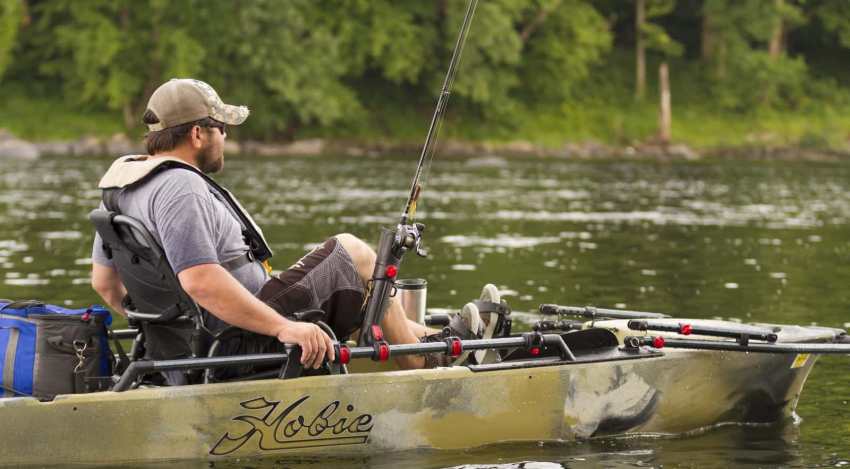
There are kayaks specifically built for fishing—even called fishing kayaks! They are wider, have better primary stability, and will have space specifically included for your bait and tackle boxes, fishing rod, and other gear.
Even recreational kayaks can be used for fishing, though they’re not quite as stable as fishing kayaks.
Fishing from your canoe is easy. After all, they’re stable and great for paddling on calm water. You’ll have space enough to store all your gear and whatever you catch, but they’re not specifically designed for fishing like fishing kayaks are.
Canoes are more stable, give you more room to move around, and let you shift positions to really lean into hauling on that rod.
At the end of the day, it’s all about where you’re fishing and the weather/water conditions you expect to find.
If there is any chance of high winds, rough waters, or having to maneuver around obstacles close to the shore, kayaks are the clear winner.
But if the day is calm and clear and you’re out in the middle of the lake, both fishing kayaks and canoes make for a great place to fish.
To Sum Up: Canoes offer better stability and more room to move. Kayaks—specifically fishing kayaks—are built to make fishing easier and more comfortable.
Paddling in a Group
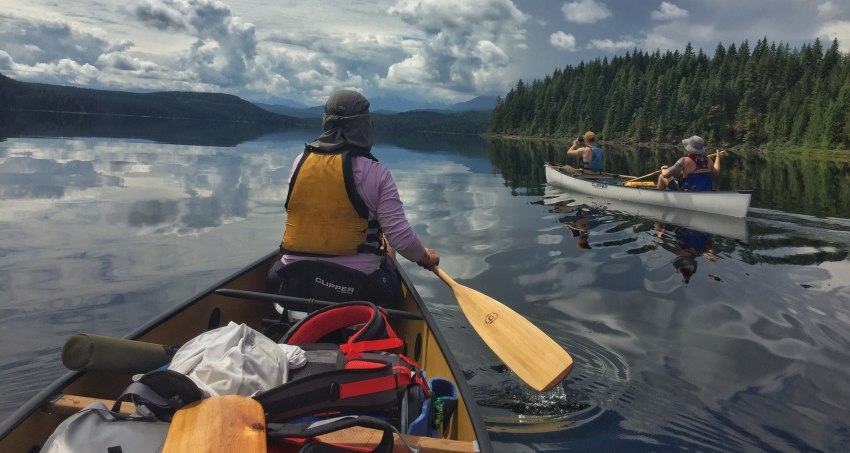
How often do you plan to solo paddle? Are you the sort of person who loves taking long trips across lakes or down rivers all on your own? Or is this something you want to do with friends and family, possibly combining it with a camping or hiking trip?
For solo adventures, kayaks are usually the better choice. They’re just easier to paddle alone, and they’re safer if you find yourself in a situation where you need to self-rescue. Canoes can be paddled alone, but it’s definitely more difficult than paddling a kayak solo.
On the other hand, if you’re paddling with a lot of others, canoes may be the better choice.
First off, they have more seats and space for more paddlers. A tandem kayak can only fit two people, but a canoe can accommodate 2-4 people (more, if there are small children). Plus, handling a canoe is always better with two or more paddlers.
They’re also more spacious, perfect for kids and pets who might get bored sitting perfectly still all day, and who might want to play in the water. The fact that you can haul extra gear for camping, hiking, and enjoying the great outdoors is a win.
To Sum Up: Take a kayak on your solo adventure, but consider a canoe for family/group outings.
Storage
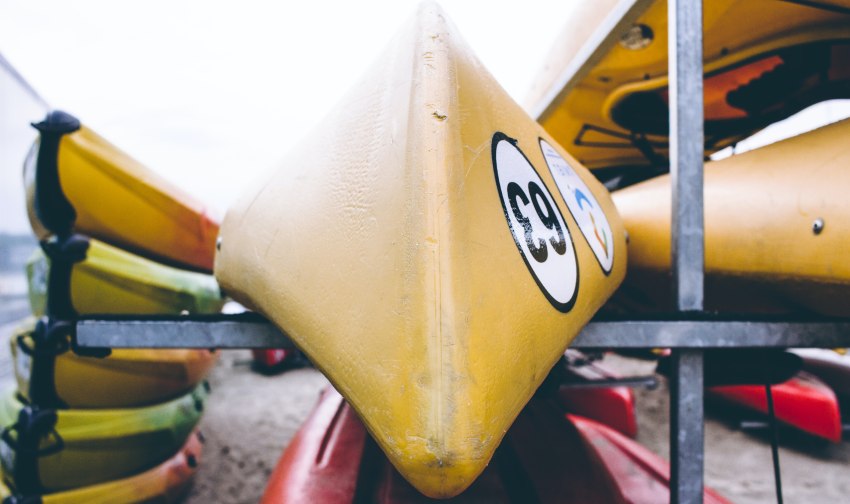
Last, but certainly not least, we’ve got to consider the storage factor.
Specifically, how easy it is to store your kayak or canoe in your home.
There are plenty of options for storing kayaks inside your garage or even a shed. Recreational and fishing kayaks—which range between 8 and 14 feet—are the easiest to store.
We did a complete list of the best kayak storage racks that will be compatible with even a small 1-car garage.
Kayaks can even be hung from the roof using a kayak hoist system.
Canoes, on the other hand, prove a bit trickier to store. They’re wider, longer, and heavier, so you can’t hang them on a simple J-rack like you can with a kayak. You’ll have to get storage racks that are compatible with the dimensions/weight of the canoe, and it will occupy more space in your garage.
It’s not common to see canoes hung from kayak roof hoists. Typically, they’re stored on standing racks rather than suspended from the walls or ceiling. For those with plenty of yard space or additional storage room, it’s not a problem. People in apartments or townhouses may find canoes are just too bulky to easily store in their homes.
To Sum Up: The smaller, lighter, and more compact kayaks are always easier to store than the bulkier and heavier canoes.
Kayak vs. Canoe: The Verdict
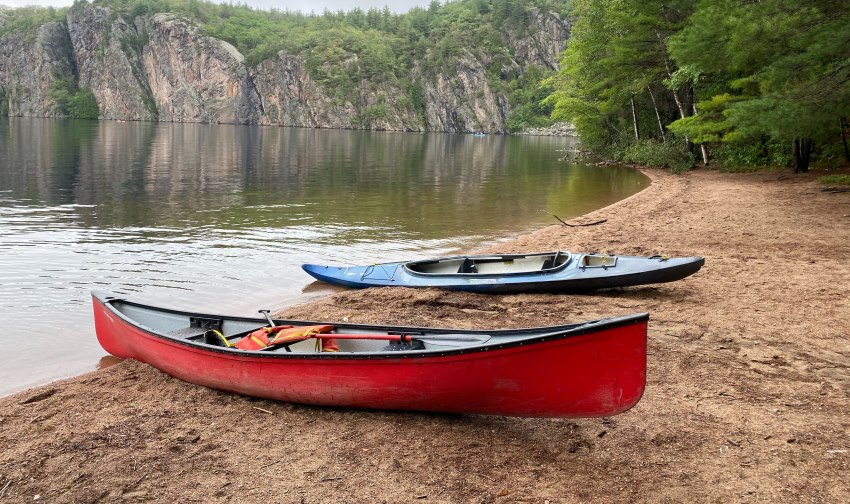
Phew, what a long list! Who knew there were so many features and factors to consider when debating buying a kayak vs. canoe.
I know I gave you the pros and cons list at the top, and you can head back up to see it for yourself to help you make the decision.
At the end of the day, though, it comes down to a few simple questions:
- How much of a learning curve do you want to go through to get paddling? If you want to hit the water NOW, choose a kayak. If you’re willing to work a bit more to get the hang of things, canoes are a great option to advance beyond beginner rowing to intermediate and advanced adventures.
- Are you paddling alone or in a group? Kayaks are great for solo adventures, and you can easily store/transport multiple kayaks to do family/friend outings. On the other hand, with just one canoe, you’ve got space for pets, kids, and/or buddies.
- What vehicle are you driving? Smaller cars and compact SUVs are better suited to transporting kayaks. Larger SUVs and trucks can handle a canoe no problem.
- Where will you be paddling? If you live by the ocean, you’re likely better off with a kayak. Calm lakes and rivers are great for canoeing, but windy lakes and faster-flowing rivers (with rapids) are better with a kayak.
- What weather and water conditions are you expecting? If you paddle only in warm/hot weather, a canoe is a great choice. But kayaks keep you dry (and warm) in chilly weather, so they’re great for paddling even in early spring or late fall.
- What kind of paddling trips will you be planning? For those planning to hit the lake, river, or ocean for a day or two, kayaks will usually have ample storage space. But if you’re planning a multi-day trip or want to haul enough gear to camp, a canoe may be your best option.
My personal preference is kayaking. I do most of my paddling solo (while listening to audiobooks), and I can go for hours on my own, navigating smaller tributaries and inlets in my Azul Riot. But if I was planning a trip with buddies, I’d definitely consider trying a canoe. Being a tall guy, I’d love a bit more room to stretch and move around.
Whichever you choose, know that both kayaks and canoes are a whole heck of a lot of fun. You’ll love all the time you spend out on the water, under the sun, and enjoying the beauty of nature.
Happy paddling!

